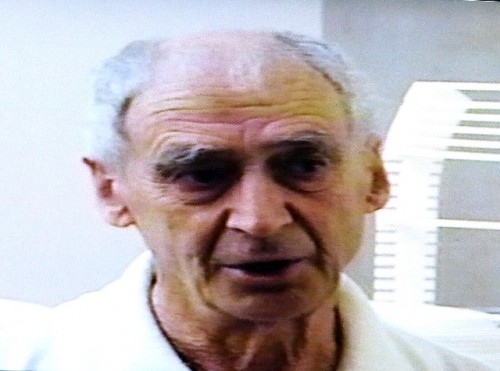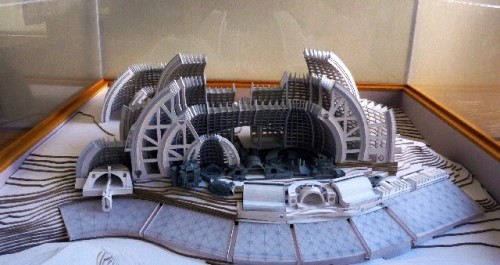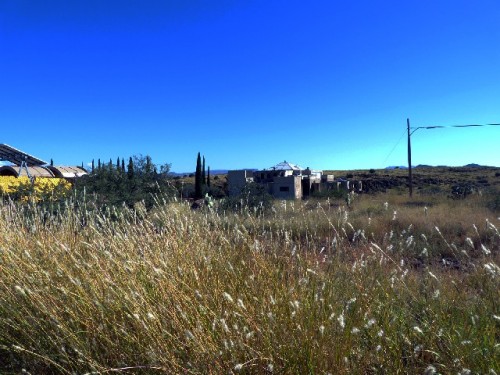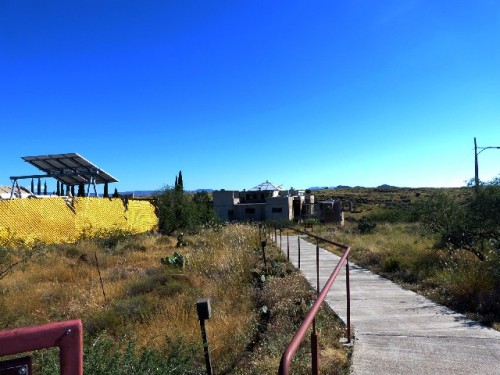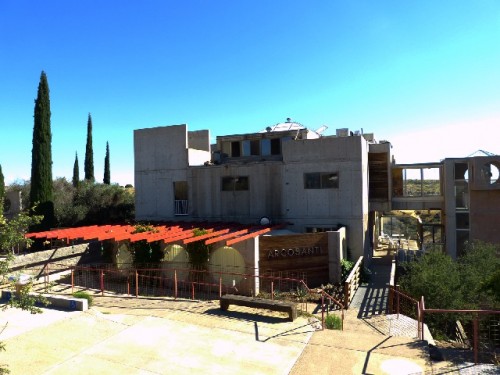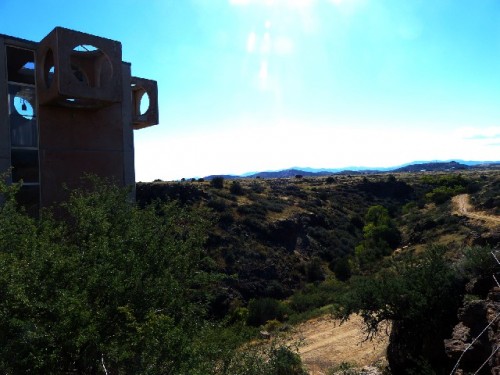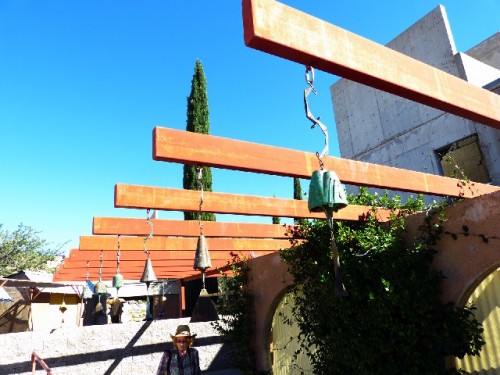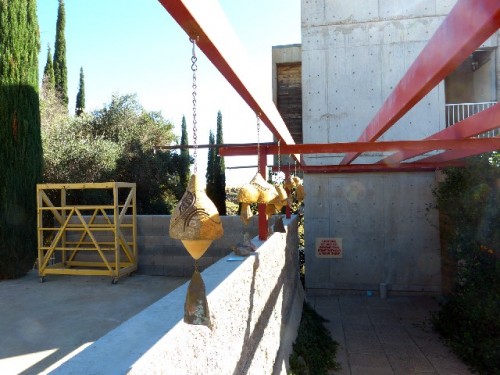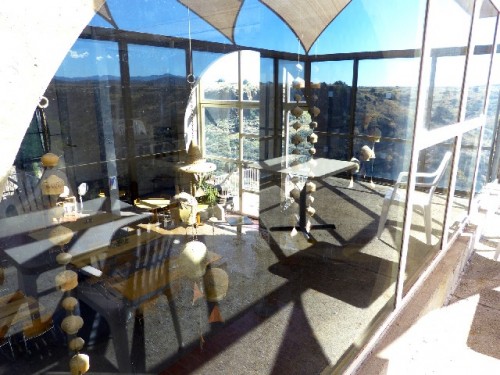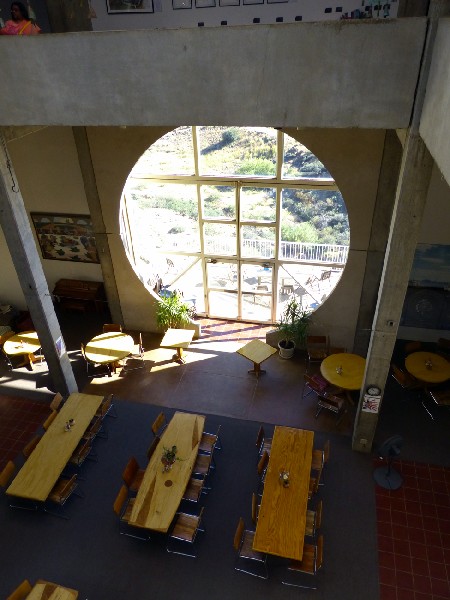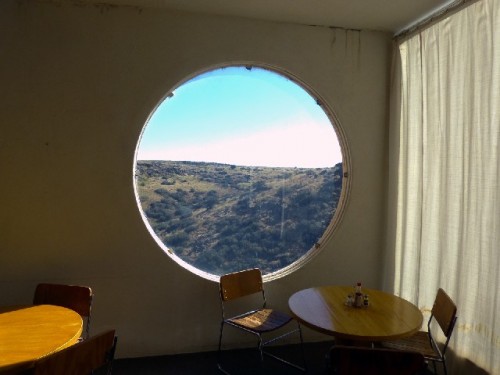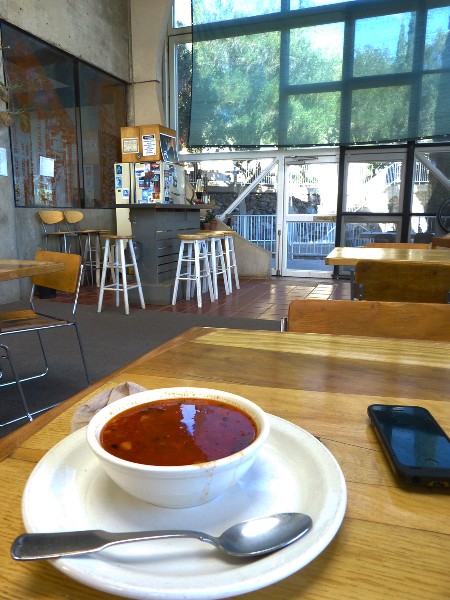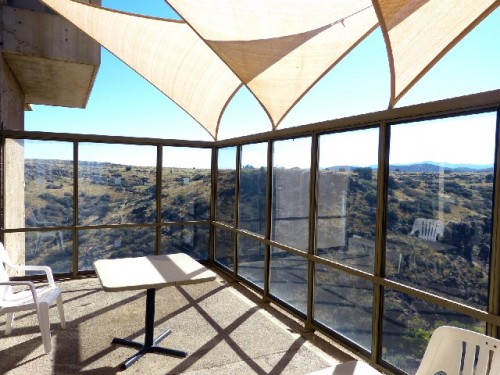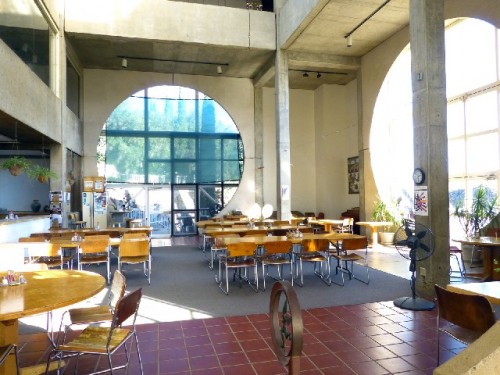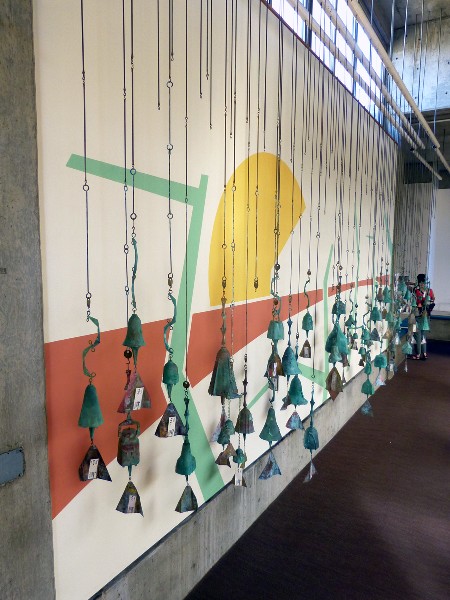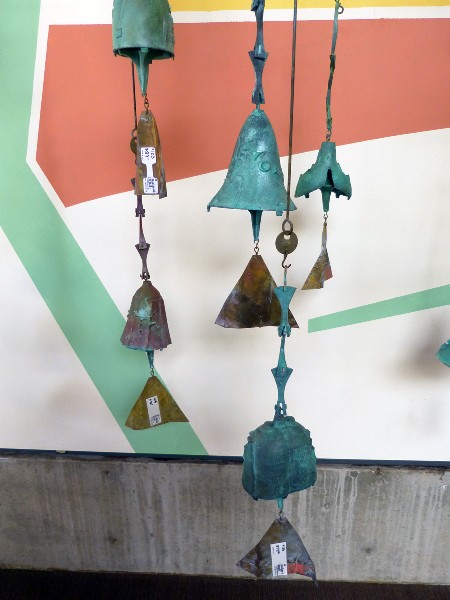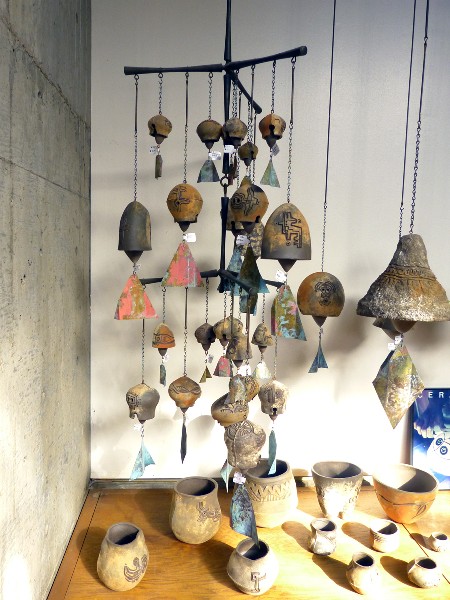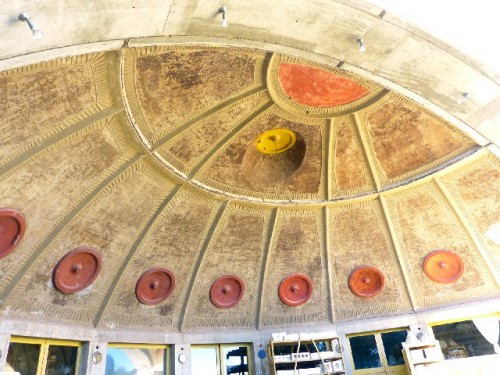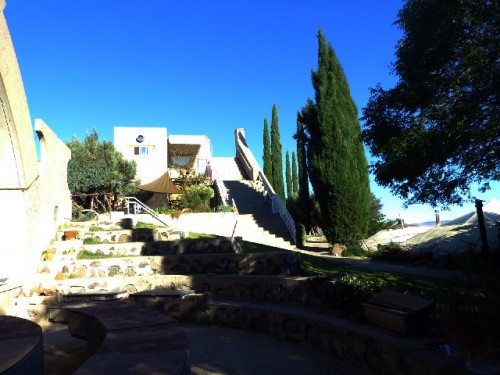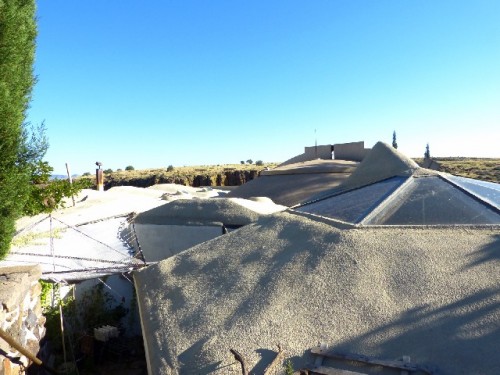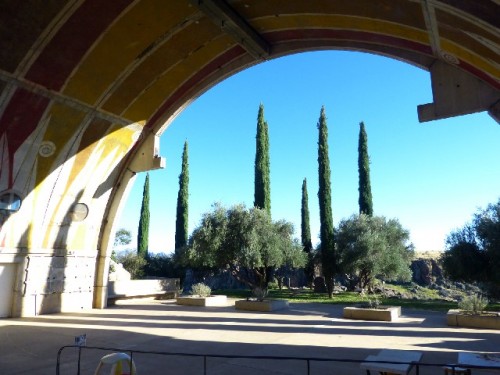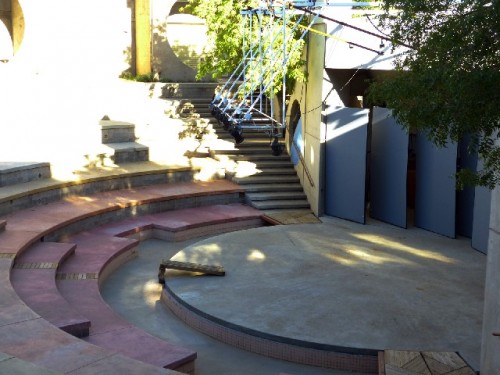Arcosanti Rings a Bell
Desert Laboratory of Architect Paolo Soleri
By: Charles Giuliano - Oct 22, 2014
During the 70 mile drive from Phoenix to Arcosanti, the desert community of visionary architect Paolo Soleri (21 June 1919 – 9 April 2013) there is a dramatic change of terrain. Mountain ranges flank the broad valley. The familiar landscape of tall, branched cacti merges into a high mountain plateau. The dominant vista is one of dried grass and scrubby bushes
The Italian born architect purchased land and established a laboratory for experimental architecture above an aquifer some 75 feet below ground. Water is essential to sustain life in the desert. Sunlight, a readily available and free resource, was used as passive solar energy in designs which were experimental when he started construction with groups of interns and followers in 1970.
He was a lecturer in architecture at Arizona State University.
It was an approach similar to the development of Taliesin West where Soleri had been a fellow for a year and a half in 1946. He had earned the equivalent of a master’s degree at Politecnico di Torino when he migrated from Italy to study with Frank Lloyd Wright.
While Soleri absorbed much from Wright he developed as a more radical theorist and visionary. Wright survived the Depression to become an amazingly prolific architect. By contrast relatively few of Soleri’s designs were constructed. Early on he received professional recognition for a bridge design shown at MoMA.
In 1966, he began working on the design for the Paolo Soleri Ampitheatre in Santa Fe, New Mexico. It was built for the IAIA (Institute of American Indian Arts) on what is now the campus of the Santa Fe Indian School using large silt cast forms. The property is owned by the nineteen Native American Pueblos of New Mexico and is therefore not protected by local or state preservation laws.
His legacy is sustained by an archive of plans and drawings at Arcosanti and by the Cosanti Foundation as well as by theories and publications on urban design. His drawings are much admired and have been seen in stunning exhibitions.
Before a tour of Arcosanti there is a brief video that presents his critique of urban sprawl which has resulted in the destruction of organic communities, the decay into slums of inner cities and exploitation of land and natural resources.
The concept of Arcosanti was to create a dense and interactive community of some 5,000. They would live, work and share cultural resources in a self contained environment. Living where you work with adjoining greenhouses, gardens and orchards eliminated the need for the dominance of the automobile.
If Arcosanti was a small scale laboratory of his concepts he had plans for larger communities and cities in a range of environments and climates. People would be transported about with the kinds of moving sidewalks that we encounter in airports. There would also be elevators and escalators connecting multi leveled construction over a contained footprint. Cities would be built up and not out.
How different from the typical American who today spends hours on congested and polluting highways commuting to and from work.
Soleri returned to Italy in 1950 where he was commissioned to build a large ceramics factory, "Ceramica Artistica Solimene," in Vietri on the Amalfi coast. From what he learned of ceramics came the development of his bells in clay and bronze. After several years in Europe he and his wife Colly settled in Scottsdale, Arizona where in 1956 he started a home, foundation for urban design, and bell studio Acosanti.
Since his death the Acosanti Foundation has been reorganized by a number of successful former fellows. They are developing long range strategic planning to fundraise and eventually complete Soleri’s design for Arcosanti. During his lifetime only a fraction was built. Currently about 55 live and work on site. The bells continue to be produced and sold following his designs. The income from that activity barely sustains and maintains the structures.
When we visited Taliesen West we learned that because of building code changes his original designs are no longer available. The same may be said of Solieri’s concepts which were too radical for their time and while widely influential are today largely outmoded. Not all of Wright’s innovations worked. The Guggenheim Museum, as just one example, underwent extensive renovation.
While relatively brief the hour long tour of Arcosati proved to be fascinating and insightful.
The site is exposed to extremes of weather. Summer temperatures hover around 100 degrees. Winter temperatures are at and below freezing. Using passive solar there are large windows to capture the heat of winter sun. During summer they are whitewashed with a layer of lime. This surface reflects light and is readily hosed and scrubbed off for winter.
In the areas for bronze and ceramic crafting this activity is located beneath hemispheres for shade during the summer and to capture and covey indoors the heat of kilns and foundries during the winter. We passed by clusters of apartments and common areas. There was an open outdoor theatre. Above were wires to suspend movable canopies for shade and shelter for rain. In front of the stage is a moat for cooling as well as to improve acoustics.
Through October there is a program of performances. During the Woodstock era there were rock concerts at which kids camped out. They proved to be problematic.
In the use of vaulting one sensed Soleri’s Italian heritage. One was constantly reminded of Roman designs such as the dome of the Pantheon or the barrel vaulting of early Christian churches. The bench design of the outdoor theatre evoked those in ancient Greece.
Perhaps the enigma of Soleri was the manner in which he straddled tradition and innovation.
As land, resources and increasing pollution become ever more a concern the visionary designs of Soleri will likely provide concepts for a more viable and sustainable future. With global population at 7 billion and no end in sight the radical designs of Soleri are no longer far out.
Committing to completing Arcosanti is a step toward realizing his vision of it as a laboratory for urban design. There is much to be learned. Think about it the next time you are stuck in traffic on the way to work or the mall.
In his concept living in one location, working at another, shopping and being entertained at yet another just doesn't make sense. Indeed, why are we spending much of our life running from here to there?

